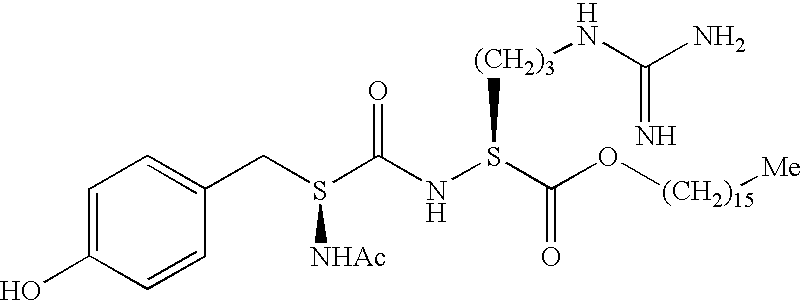Use of tyrosine-arginine dipeptide and niacinamide as substance p antagonist
a technology of tyrosine-arginine dipeptide and niacinamide, which is applied in the directions of dipeptide ingredients, cosmetic preparations, cosmetic preparations, etc., to achieve the effect of improving activity
- Summary
- Abstract
- Description
- Claims
- Application Information
AI Technical Summary
Benefits of technology
Problems solved by technology
Method used
Image
Examples
example 1
Histological Evaluation of the Average Surface Area of the Capillaries
[0194] The tests of Examples 1 and 2 hereinafter were carried out with niacinamide at a final concentration of 0.5% and N-acetyl-tyrosine-arginine-decahexyl ester, provided by the company Sederma, at a final concentration of 0.1%; its chemical structure is as follows:
[0195] The activity of each of the active agents and of the combination thereof is evaluated in a model of human skin kept under survival conditions. After several hours of re-equilibration of the skin with culture medium (antibiotic+SVF), the culture medium is renewed and substance P at 10 (M, with or without each of the active agents or the combination thereof, is (are) added to the culture medium.
[0196] Irrespective of whether they are alone or in combination, the active agents are used at the final concentrations of 0.1% for the niacinamide and 0.5% for the dipeptide.
[0197] Morphometric analysis of the surface area (μm2) occupied by the lumen...
example 2
Histological Evaluation of Dermal Oedema
[0202] Using the sections prepared in Example 1, the oedema is evaluated by means of semi-quantitative scores: [0203] score 0: no oedema [0204] score 1: very slight oedema [0205] score 2: moderate oedema [0206] score 3: considerable oedema
[0207] The score for the control skin is 0.86+ / −0.7. The treatment with substance P results in a 121% increase in the oedema score (1.9+ / −0.64).
Percentage of dilatedTreatmentdermal capillariesControl skin0.86 + / − 0.7 Skin + substance P1.9 + / − 0.7Skin + substance P + niacinamide1.03 + / − 0.64Skin + substance P + dipeptide 1 + / − 0.6Skin + substance P + niacinamide +0.78 + / − 0.3 dipeptide
[0208] The treatment with each of the active agents makes it possible to significantly decrease the oedema compared with the substance P-stimulated skin (p<0.05). The combination of the two active agents also induces a decrease in the dermal oedema compared with the skin subjected to substance P and compared with the control...
example 3
Compositions
Oil-in-water Emulsion
[0212] A—Water . . . QS 100% [0213] Preserving agents . . . 0.5% [0214] Glycerol . . . 5% [0215] Niacinamide . . . 2.5% [0216] Dipeptide . . . 2.5% [0217] Caffeine . . . 0.3% [0218] Dipeptide . . . 1% [0219] B—Glyceryl stearate and PEG-100 stearate . . . 3% [0220] Stearic acid . . . 1% [0221] Cetyl alcohol . . . 2% [0222] Isononyl isononanoate . . . 10% [0223] Acrylate copolymer . . . 0.3% [0224] C—Cyclohexasiloxane . . . 5% [0225] Carbomer . . . 0.3% [0226] Xanthan gum . . . 0.2%
Procedure
[0227] Phase A is heated at 85° C., with agitation, until a clear phase is obtained and is then brought back to 70° C.
[0228] Phase B is heated to 70° C. and homogenized with agitation and then added to phase A for emulsification with agitation. The whole is brought back to 30° C.
[0229] The xanthan gum and the carbomer are dispersed in the cyclohexasiloxane at ambient temperature until a homogeneous phase is obtained, and then added to the mixture A+B.
[0230]...
PUM
| Property | Measurement | Unit |
|---|---|---|
| Fraction | aaaaa | aaaaa |
| Percent by mass | aaaaa | aaaaa |
| Fraction | aaaaa | aaaaa |
Abstract
Description
Claims
Application Information
 Login to View More
Login to View More - R&D
- Intellectual Property
- Life Sciences
- Materials
- Tech Scout
- Unparalleled Data Quality
- Higher Quality Content
- 60% Fewer Hallucinations
Browse by: Latest US Patents, China's latest patents, Technical Efficacy Thesaurus, Application Domain, Technology Topic, Popular Technical Reports.
© 2025 PatSnap. All rights reserved.Legal|Privacy policy|Modern Slavery Act Transparency Statement|Sitemap|About US| Contact US: help@patsnap.com

